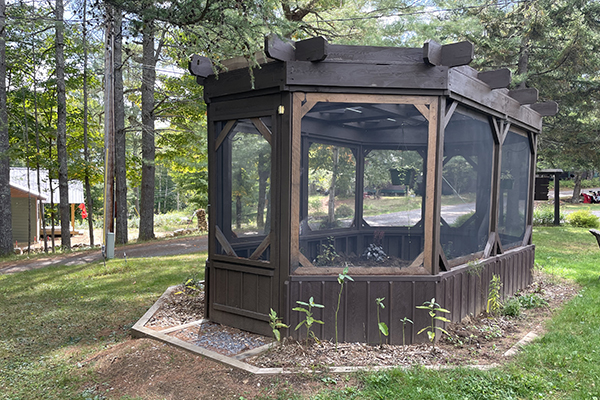
09/23/2025
The Butterfly House opened with little fanfare this past summer at Antlers, the less remote of two Adirondack camps comprising SUNY Cortland’s William H. Parks Family Center for Environmental and Outdoor Education at Raquette Lake, N.Y.
Six monarch butterflies — Danaus plexippus — arrived at the screened, gazebo-like structure in the form of black-yellow-and-white banded caterpillars. Spinning themselves into a glossy, mint green chrysalis state, they literally hung around for a couple weeks before emerging one by one to perch on the wooden beams gently flexing their new wings. Staff bid them goodbye the next day as they departed aloft on a long, multigenerational trip to Florida or Mexico.
During their stay, the monarchs refreshed themselves on the nectar and fresh leaves of an assortment of herbs planted in soil both inside and outside the Butterfly House: common milkweed, Wild bleeding heart, Joe-Pye weed, Seaside goldenrod and Scarlet bee balm.
A few inquisitive humans, mostly Antlers campers staying nearby through SUNY Cortland’s educational and alumni recreational programs, visited the brand-new campus structure between the Main Lodge and Cedars.
In the future, other insects in the order Lepidoptera shared by butterflies and moths are expected to use the friendly accommodations, said Rhonda Jacobs Pitoniak ’01, M ’16, director of the Parks Family Outdoor Center.
“According to the Adirondacks Forever Wild Page, the park has 74 species of butterflies and moths,” Pitoniak said. “The ones we see the most around here are the monarchs.”
However, Painted Ladies, Tiger swallowtails, Cecropia silk moths, Luna moths and both White and Red Admirals — all large and showy celebrities of the moth and butterfly world — are expected to make brief Butterfly House appearances.
Steven Broyles, SUNY distinguished teaching professor emeritus of biological sciences, conceived of this unusually porous shelter with its removable screened side and ceiling panels.
“It’s something that Steve talked about for a long time that would be helpful for the Field Biology class,” Pitoniak said. “But it would also be good for visitors of any kind, whether they were college students, middle school, high school students or families.”
Alum Daniel Scheffer ’96 made a gift to support construction of the butterfly abode.
Broyles, who retired in 2024, said Scheffer took his Field Biology course in the 1990s although Scheffer’s chosen field in which he ultimately graduated was physics.
“As a natural scientist, Dan had great curiosities about everything,” Broyles said. “He was a marvelous student and friend. I remember he was energetic, intelligent and funny.”
When Scheffer let Broyles know in 2019 he planned a major gift to benefit the Field Biology class, the professor realized the size of the gift offered great potential.
“One of my goals was to create something that would work for onsite science education that could also invite the community to visit the Cortland facility at the Antlers,” Broyles said. “Dan was supportive.”
Additionally, SUNY Cortland’s Division for Institutional Advancement wrote a successful grant application from the John Ben Snow Foundation and Memorial Trust, a Manlius, N.Y.-based nonprofit, to cover hiring the first Butterfly House steward to serve in the role this past summer, Autumn Stoia, and another through next June 2026.
Parks Family Outdoor Center staff plan weekly summertime tours for the public.
“It’s a both formal and informal way to share environmental education,” in terms of the student versus the public experience of the facility, Pitoniak said. “It’ll give a student employee the opportunity to learn how to improve their interpretive skills and talk with the public of all different ages.”
Joe Westbrook, lead campus architect in the university’s Facilities Planning, Design and Construction Office, designed the facility.
“It would mimic a gazebo because there were so many around Antlers originally,” Pitoniak said.
“We came up with the exterior footprint in conversations between me and Steve and Joe and Deb (Faylo, assistant director of outdoor education, who manages Antlers),” Pitoniak said.
Wes Lamphear, owner of the builder, West Structures Construction Co., helped design the unique interior design of screens attached to removable panels for the sake of their preservation in winter storage.
Stoia, volunteers and staff members researched all the ideal plants to attract and feed butterflies, bought the stock, prepared the soil for and installed the garden, leaving the insects only about two weeks to safely metamorphosize inside the shelter.
The recent monarch visitors represent possibly the great-grandchildren of butterflies that started the trip from Mexico, with parents stopping perhaps in Tennessee or Kentucky to lay a set of approximately 100 eggs along the way.
“This is the northern-most reaches for them,” Pitoniak said.
“On Monarchwatch.org, there’s actually a map that shows their migration,” Pitoniak said. The site features stickers that citizen scientists can use to attach to a butterfly’s wings and help scientists track the monarch’s travels.
The university only gives its guests at the Butterfly House a short-term accommodation.
“We don’t keep butterflies more than a day or two after they hatch because we want them to continue their natural cycle,” Pitoniak said. “It’s a way to preserve and help some butterflies through to adulthood to, hopefully, start the next cycle.”
“We would like to thank Daniel for his gift to support the construction of the butterfly house at Antlers, our iconic facility in the Adirondacks,” said Rich Coyne ’07, M.S., the university’s vice president for institutional advancement.
“This project exemplifies Cortland’s dedication to enhancing the quality of life through environmental, educational, arts and cultural endeavors.”
Coyne continued, “Through the power of donor philanthropy and the generosity from the John Ben Snow Memorial Trust, Cortland continues to provide students unique experiential learning opportunities relative to their area of study.”
Select an image to start a slide show




